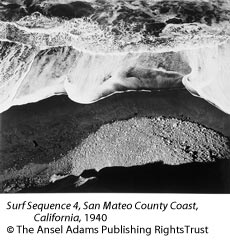|
Surf Sequence 4, San Mateo County Coast, California,
c.1940
Plate 29 in Ansel Adams - Classic Images
Main Source: Examples - The Making of 40 Photographs by Ansel
Adams, pp 23-26
A. How did Adams arrive at taking Surf Sequence?
B. Why is Surf Sequence significant?
C. What special problems and opportunities did the
subject bring?
D. What difficulties were presented during printing?
E. How did Adams meet the darkroom challenges?
F. Technical Aspects
G. Related links in this site
A. How did Adams arrive at taking Surf Sequence?
One morning Adams was driving along the coast and frequently stopped
the car to look out from the cliffs at the lively surf below. "At
one location I noted that below me was a nice curve of rockfall fronting
the beach. The surf was streaming over the beach, barely touching the
rocks and creating one beautiful pattern after another. I realized that
I could perehaps make a series of images that might become a sequence..."
He set up his camera and waited for an "appealing arrangement of
flowing water and foam."
...back to top
B. Why is Surf Sequence significant?
According to James Alinder in his introduction to Ansel Adams - Classic
Images, the book on which this exhibition is based, this series
is the product of one of his "most innovative moments... It has
quiet musical and poetic changes," relating to his love of music
and poetry. Alinder add that "Adams created a consecutive image
relationship that was unprecedented, one that prefigured sequential
concerns among creative photographrs some thirty years later."
...back to top
C. What special problems and opportunities did the subject bring?
The weather concerned Adams. "It was a crisp shining day with
an approaching band of fog over the sea. There was a question of exposure
because as the white water came in and out, the light readings varied.
He chose an average. This subject was moving, unlike most of his other
subjects. He set the shutter at a fast speed, at 1/100 second. The movement
caused Adams to "try to anticipate the position of these moving
shapes in time." He failed with several of the exposures, ending
up with five satisfactory compositions out of nine negatives made. The
movement presented a new opportunity for Adams - the possibility of
sequential patterns. Adams became "aware of the relation of one
image to those preceding and following," as he imagined the final
prints. He believes they can be displayed in any order desired.
...back to top
D. What difficulties were presented during printing?
Adams said that printing was not as easy as expected. If the prints
were to be shown as a sequence, there was need for tonal balance. But
the density was not even in each negative for two reasons due to the
conditions during the twenty minutes during which Adams took all five
exposures. The first reason was that "the sun continued to rise
and the general luminance value increased; each negative was a bit more
exposed than the preceding one..." The second reason was that
as "foam and water receded from the beach, the revealed sand would
change value , gradually growing lighter as the sand absorbed the water.
After the next wave it would return to its darker value." Another
problem was that he found on three of the negatives a distracting detail..
...back to top
E. How did Adams meet the darkroom challenges?
In addition to trying combinations of various papers and developers
(see technical aspects), he engaged in "rather intricate dodging
and burning." This means he increased (burning), or decreased
(dodging) the light from the enlarger through the negative to the photographic
paper to achieve the balance of values he visualized. In this case he
also used cropping. Because he wanted all five prints to be precisely
the same size, and he had to crop (cut off) the right side of three
of the prints to eliminate a distracting shape, he had to crop all five.
He says this attention to small detail is a matter of his "desire
for perfection."
...back to top
F. Technical Aspects
- Camera: 4 X 5 view camera
- Film: ASA 64
- Lens: 10-inch (250mm) Dagor - long focus
- Light meter: Weston. Set for an average of 200 candles per square
foot
- Exposure: 1/100 second at f/11
- Paper: Agfa Brovira Grade 3 with Kodak D-23 Developer
Then Ilford Gallerie Grade 1 with quite full development in Dektol
Grade 3 Gallerie with Kodak Selectrol-Soft developer
- Toning: All prints were toned in selenium
To correct for darkroom difficulties, if he were to retake the photograph
he would use:
- Camera: Hasselblad with the prism finder
- Lens: 120 mm or 150 mm
- Film: medium speed, Plus X
- Exposure: very fast shutter speed to arrest motion
- Developer: Normal-plus-one in fairly concentrated developer solution.
...back to top
G. Related links in this site
- Lesson Plans:
- Resources:
- See Bibliography for more material
by and about Ansel Adams. For more information on the technical
aspects - cameras, films, lenses, filters, darkroom techniques,
printing, papers, etc. - please refer to Examples, The Making
of 40 Photographs by Ansel Adams (Boston, Toronto, London:
Little, Brown and Co, 1983).
- About Photography
- See Glossary for definitions
of vocabulary words and photography terms.
|
